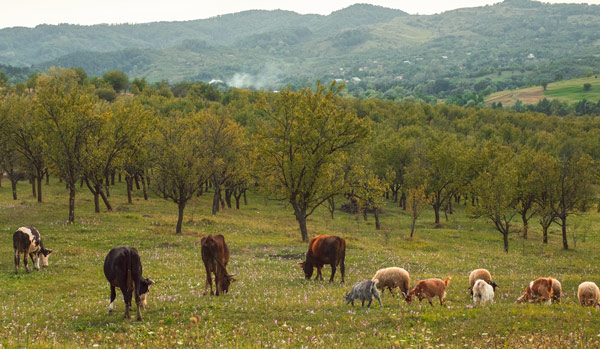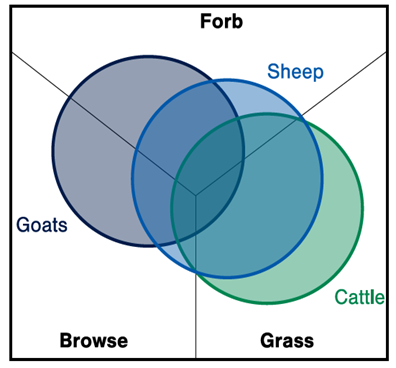Arkansas Extension Small Ruminants
Contact
Dr. Dan Quadros
Asst. Professor - Small Ruminants
Phone: 501-425-4657
Fax: 501-671-2185
Email: dquadros@uada.edu
University of Arkansas System
Division of Agriculture
Cooperative Extension Service
2301 S. University Ave.
Little Rock, AR 72204
Increasing Profitability of Beef Cattle Operations With Small Ruminants
By Dr. Dan Quadros, UADA Small Ruminants Specialist
Pamela Rogers, UofA graduate student
July 27, 2023
Adding sheep and goats to a cow-calf or stocker/background operations can increase efficiency of livestock production.
 The benefits of adding small ruminants in a beef cattle operation includes, but are
not limited to:
The benefits of adding small ruminants in a beef cattle operation includes, but are
not limited to:
- Diversification of assets and extra cash flow
- Small ruminants are small, prolific, and productive
- Quick return of investment
- Easy management and handling
- Weed and brush control
- Increase of land use and overall productivity
- Helps to control parasites
Adapting existing beef cattle facilities to small ruminants makes the process cheaper, easier, and with lower break-even point. Before discussing economics, it is important to follow the steps to adapt your farm to manage small ruminants with the 5 Fs:
- Forages
- Feeds
- Facilities
- Fencing
- Finances
Forages
Arkansas is in the climatic transition zone, that supports a variety of forage plants, such as warm and cool season, perennial and annual grasses, as well as forage legumes. For instance, if you cultivate summer annuals and small grains, it can help bridge the gap of a lack of forage quantity and quality between growing seasons, diversify forage sources, and provide nutrients to increase the performance of livestock. When adding small ruminants to your farm, remember to choose forage species based on adaptability, yield, management, and nutritional value.
While cattle prefer grasses, sheep have a considerable proportion of forbs in their
diets, and goats prefer a majority of forbs and shrubs (Figure 1). Small ruminants
have the ability to consume plants that are undesirable to cattle. Sheep and, notably,
goats have a larger liver (by body weight percentage) and they also have a more active
detoxification system than cattle, that allows them to process a higher concentration
of substances that cause unpalatability.
Adapted from Walker et al. (2006) by Whaley and Bachler (2022)
Figure 1. Dietary overlap of ruminant livestock
If forages are available, you can begin your co-grazing project by adding one ewe or doe per cow. There are two options for how the animals should graze, separately or through flerding methods. Flerding is another word for co-species grazing. If the animals are separated, small ruminants do not have the protection against predators that cattle can offer, but it is safer regarding water systems, supplements/minerals and can limit competition amongst the animals.
A rotational grazing system is recommended for co-grazing projects because of the different grazing behaviors and nutritional needs. When rotating your animals, allow the sheep and goats to graze first and have the cattle follow since they consume more fibrous parts of the plants and can reduce parasite loads.
It is important to not let small ruminants overgraze to avoid consuming larvae that are at the lower parts of the plants. Most larvae are located at a height of four inches and below. Avoiding these lower forage heights can drastically reduce the parasite load in the animals.
Feeds
Special feeders can be placed on the fields that are high enough for cattle to reach but limit the accessibility for sheep and goats. Goats are known for their ability to climb, though.
It is important to mention that cattle, goats and sheep have different mineral requirements. For instance, goats have a moderate copper requirement, but if a sheep is fed copper for a lengthy period of time, it can lead to toxicity. If raised together, it is safer to use sheep minerals for both sheep and goats and supplement copper for goats when necessary.
If your herd is fed via trough, then it is a good idea to separate the cows and sheep/goats during mealtime and fill the troughs beforehand or use a feeding device that does not allow the sheep and goat access to feeds as cattle feeds can cause metabolic problems in small ruminants.
Facilities
Working facilities and equipment for small ruminants are simple additions if there are already cattle facilities in place. Extra items can include a shorter water tank, working chute, space in the current handling facility and type of fencing. Shelter is recommended to protect small ruminants against inclement weather, mainly for goats.
Fencing
Conventional permanent fencing for small ruminants that works very well is woven wire fencing. But, to reduce the investment, 5-8 strings, electrified high-tensile wire fencing became popular, with electric netting/tape/rope/twine mobile fences as cross fencing. Electric tape does not work well for wooled sheep.
Remember that small ruminants, notably goats, are more difficult to contain than cattle. Goats can hop on and duck underneath a fence. Therefore, it is a good idea to invest in fencing that will last and support both cows and small ruminants, as well as protect against predators like coyotes and neighborhood dogs.
Adapting your existing fence to sheep and goats requires using additional wire strings or hot wires. If you have, for instance, a 5-string barber wire fence, you will need to add 3 more strings, two below the first string (4” apart) and one additional string between your current first and second strings. If the new wires are electrified, it is even better for deterring predators.
Finances
Adding small ruminants in a cattle operation could mean more investments in facilities, feed, and labor, but, if managed well, the financial return is guaranteed. The scenario below is a hypothetical case based on adding sheep to an existing cow-calf operation.
Assumptions:
- Area: 100 acres
- Stocking rate: 2 acres per cow = 50 cows
- Adding 1 ewe per cow
- 100% natality rate and 0% mortality rate (hypothetical)
- Lambing crop: 150%
Prices based on historical prices for calves and lambs.
Scenario 1: Cattle alone
- 50 cows
- Production of 50 weaning calves/year
- Weaning weight of 600 lb/calf = 50 calves x 600 lb/calf = 30,000 lb
- Average price of $1.75/lb
- Gross revenue = 30,000 lb x $1.75/lb = $ 52,500
- If 30% Net profit = $15,750/year
Scenario 2: Extra income generated by small ruminants
- 50 ewes and 150% lamb crop per year
- Production of 75 weaning lambs/year
- Weaning weight of 50 lb/lamb = 75 lambs x 50 lb/lamb = 3,750 lb
- Average price of $2.8/lb
- Gross revenue = 3,750 lb x $2.8/lb = $10,500/year
- If 30% net profit = $3,150/yr (+20% extra)
- Note: Adapting facilities can increase the net profit to 50-60%, then = $ 5,775/yr (+37% extra)
In case you decide to background them on farm and sell the lambs with 80lb, the price per pound may reduce a bit, but you can increase gross revenue:
75 lambs x 80 lb x $ 2.2/lb = $ 13,200 of gross revenue, considering 30 to 55% net profit = $ 3,960 to 7,260 (+25 to 46% extra).
In summary, adding small ruminants to a beef cattle operation can increase efficiency and generate extra net profit from 20 to 46%. However, small ruminants require investment, mainly in fencing, and management as they are more labor-intensive than cattle.
Bibliography
Rinehart, L. (2018, September). Multispecies grazing: A Primer on diversity. Multispecies
Grazing: A Primer on Diversity. NCAT/ATTRA. Available through ATTRA Sustainable Agriculture Accessed 06-26-23
Walker, J.W.; Coffey, L.; Faller, T. (2006). Improving grazing lands with multi-species grazing. Targeted grazing: a natural approach to vegetation management and landscape enhancement, 50-55. Available through from Nebraska Extension Accessed 06-26-23.
Whaley, J.; Bachler, J. (2022) Multispecies Grazing: Benefits of Sheep Integration on Rangelands. Accessed 06-26-23.